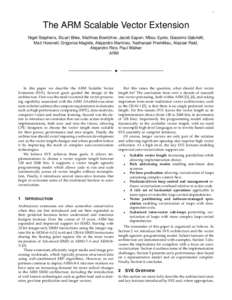The ARM Scalable Vector Extension
ARM Ltd[pdf] [doi]
IEEE Micro 37(2)
arXiv:1803.06185 [cs.AR]
March 2017
Abstract
In this paper we describe the ARM Scalable Vector Extension (SVE). Several goals guided the design of the architecture. First was the need to extend the vector processing capability associated with the ARM AArch64 execution state to better address the compute requirements in domains such as high performance computing (HPC), data analytics, computer vision and machine learning. Second was the desire to introduce an extension that can scale across multiple implementations, both now and into the future, allowing CPU designers to choose the vector length most suitable for their power, performance and area targets. Finally, the architecture should avoid imposing a software development cost as the vector length changes and where possible reduce it by improving the reach of compiler auto-vectorization technologies.
We believe SVE achieves these goals. It allows implementations to choose a vector register length between 128 and 2048 bits. It supports a vector length agnostic programming model which allows code to run and scale automatically across all vector lengths without recompilation. Finally, it introduces several innovative features that begin to overcome some of the traditional barriers to auto-vectorization.

BibTeX
@article{journal/micro/sve2017 , abstract = { In this paper we describe the ARM Scalable Vector Extension (SVE). Several goals guided the design of the architecture. First was the need to extend the vector processing capability associated with the ARM AArch64 execution state to better address the compute requirements in domains such as high performance computing (HPC), data analytics, computer vision and machine learning. Second was the desire to introduce an extension that can scale across multiple implementations, both now and into the future, allowing CPU designers to choose the vector length most suitable for their power, performance and area targets. Finally, the architecture should avoid imposing a software development cost as the vector length changes and where possible reduce it by improving the reach of compiler auto-vectorization technologies.We believe SVE achieves these goals. It allows implementations to choose a vector register length between 128 and 2048 bits. It supports a vector length agnostic programming model which allows code to run and scale automatically across all vector lengths without recompilation. Finally, it introduces several innovative features that begin to overcome some of the traditional barriers to auto-vectorization. } , affiliation = {ARM Ltd} , ar_file = {IEEE_Micro} , ar_shortname = {IEEE Micro} , archiveprefix = {arXiv} , authors = { Nigel Stephens and Stuart Biles and Matthias Boettcher and Jacob Eapen and Mbou Eyole and Giacomo Gabrielli and Matt Horsnell and Grigorios Magklis and Alejandro Martinez and Nathanael Premillieu and Alastair Reid and Alejandro Rico and Paul Walker } , doi = {10.1109/MM.2017.35} , eprint = {1803.06185} , file = {sve-ieee-micro-2017.pdf} , journal = {IEEE Micro} , month = {March} , number = {2} , pages = {26--39} , png = {sve-ieee-micro-2017.png} , primaryclass = {cs.AR} , title = {{T}he {A}RM {S}calable {V}ector {E}xtension} , volume = {37} , year = {2017} }